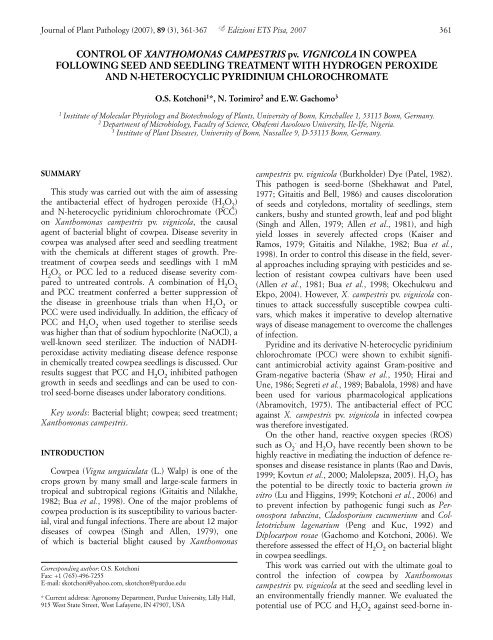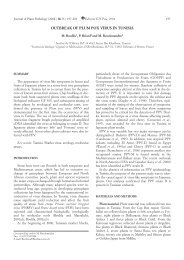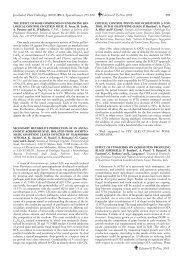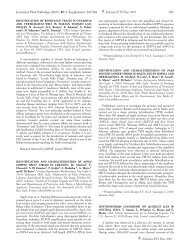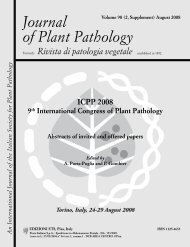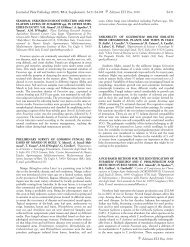CONTROL OF XANTHOMONAS CAMPESTRIS pv ... - Sipav.org
CONTROL OF XANTHOMONAS CAMPESTRIS pv ... - Sipav.org
CONTROL OF XANTHOMONAS CAMPESTRIS pv ... - Sipav.org
- No tags were found...
You also want an ePaper? Increase the reach of your titles
YUMPU automatically turns print PDFs into web optimized ePapers that Google loves.
Journal of Plant Pathology (2007), 89 (3), 361-367 Edizioni ETS Pisa, 2007 361<strong>CONTROL</strong> <strong>OF</strong> <strong>XANTHOMONAS</strong> <strong>CAMPESTRIS</strong> <strong>pv</strong>. VIGNICOLA IN COWPEAFOLLOWING SEED AND SEEDLING TREATMENT WITH HYDROGEN PEROXIDEAND N-HETEROCYCLIC PYRIDINIUM CHLOROCHROMATEO.S. Kotchoni 1 *, N. Torimiro 2 and E.W. Gachomo 31 Institute of Molecular Physiology and Biotechnology of Plants, University of Bonn, Kirschallee 1, 53115 Bonn, Germany.2 Department of Microbiology, Faculty of Science, Obafemi Awolowo University, Ile-Ife, Nigeria.3 Institute of Plant Diseases, University of Bonn, Nussallee 9, D-53115 Bonn, Germany.SUMMARYThis study was carried out with the aim of assessingthe antibacterial effect of hydrogen peroxide (H 2O 2)and N-heterocyclic pyridinium chlorochromate (PCC)on Xanthomonas campestris <strong>pv</strong>. vignicola, the causalagent of bacterial blight of cowpea. Disease severity incowpea was analysed after seed and seedling treatmentwith the chemicals at different stages of growth. Pretreatmentof cowpea seeds and seedlings with 1 mMH 2O 2or PCC led to a reduced disease severity comparedto untreated controls. A combination of H 2O 2and PCC treatment conferred a better suppression ofthe disease in greenhouse trials than when H 2O 2orPCC were used individually. In addition, the efficacy ofPCC and H 2O 2when used together to sterilise seedswas higher than that of sodium hypochlorite (NaOCl), awell-known seed sterilizer. The induction of NADHperoxidaseactivity mediating disease defence responsein chemically treated cowpea seedlings is discussed. Ourresults suggest that PCC and H 2O 2inhibited pathogengrowth in seeds and seedlings and can be used to controlseed-borne diseases under laboratory conditions.Key words: Bacterial blight; cowpea; seed treatment;Xanthomonas campestris.INTRODUCTIONCowpea (Vigna unguiculata (L.) Walp) is one of thecrops grown by many small and large-scale farmers intropical and subtropical regions (Gitaitis and Nilakhe,1982; Bua et al., 1998). One of the major problems ofcowpea production is its susceptibility to various bacterial,viral and fungal infections. There are about 12 majordiseases of cowpea (Singh and Allen, 1979), oneof which is bacterial blight caused by XanthomonasCorresponding author: O.S. KotchoniFax: +1 (765)-496-7255E-mail: skotchoni@yahoo.com, skotchon@purdue.edu* Current address: Agronomy Department, Purdue University, Lilly Hall,915 West State Street, West Lafayette, IN 47907, USAcampestris <strong>pv</strong>. vignicola (Burkholder) Dye (Patel, 1982).This pathogen is seed-borne (Shekhawat and Patel,1977; Gitaitis and Bell, 1986) and causes discolorationof seeds and cotyledons, mortality of seedlings, stemcankers, bushy and stunted growth, leaf and pod blight(Singh and Allen, 1979; Allen et al., 1981), and highyield losses in severely affected crops (Kaiser andRamos, 1979; Gitaitis and Nilakhe, 1982; Bua et al.,1998). In order to control this disease in the field, severalapproaches including spraying with pesticides and selectionof resistant cowpea cultivars have been used(Allen et al., 1981; Bua et al., 1998; Okechukwu andEkpo, 2004). However, X. campestris <strong>pv</strong>. vignicola continuesto attack successfully susceptible cowpea cultivars,which makes it imperative to develop alternativeways of disease management to overcome the challengesof infection.Pyridine and its derivative N-heterocyclic pyridiniumchlorochromate (PCC) were shown to exhibit significantantimicrobial activity against Gram-positive andGram-negative bacteria (Shaw et al., 1950; Hirai andUne, 1986; Segreti et al., 1989; Babalola, 1998) and havebeen used for various pharmacological applications(Abramovitch, 1975). The antibacterial effect of PCCagainst X. campestris <strong>pv</strong>. vignicola in infected cowpeawas therefore investigated.On the other hand, reactive oxygen species (ROS)such as O 2 - and H 2O 2have recently been shown to behighly reactive in mediating the induction of defence responsesand disease resistance in plants (Rao and Davis,1999; Kovtun et al., 2000; Malolepsza, 2005). H 2O 2hasthe potential to be directly toxic to bacteria grown invitro (Lu and Higgins, 1999; Kotchoni et al., 2006) andto prevent infection by pathogenic fungi such as Peronosporatabacina, Cladosporium cucumerium and Colletotrichumlagenarium (Peng and Kuc, 1992) andDiplocarpon rosae (Gachomo and Kotchoni, 2006). Wetherefore assessed the effect of H 2O 2on bacterial blightin cowpea seedlings.This work was carried out with the ultimate goal tocontrol the infection of cowpea by Xanthomonascampestris <strong>pv</strong>. vignicola at the seed and seedling level inan environmentally friendly manner. We evaluated thepotential use of PCC and H 2O 2against seed-borne in-
362 Control of X. campestris <strong>pv</strong>. vignicola in cowpea Journal of Plant Pathology (2007), 89 (3), 361-367fection and for an efficient control of bacterial blight inseedlings. The efficacy of PCC and H 2O 2in sterilizationof cowpea seeds was compared with that of sodiumhypochlorite (NaOCl), a known seed sterilizer.MATERIALS AND METHODSExperimental design. Unless otherwise stated, eachexperiment was repeated three times and each treatmentwithin an experiment was performed in threereplicates. For chemical seed treatment experiments,sets of 400 cowpea seeds were used per tested chemicalconcentration and per replicate, while sets of 40seeds/seedlings were used for greenhouse pathogenicitytests. Data were expressed as mean values (±SE) of atleast three independent experiments, where applicable.P values were determined by Student’s t-test analysis. Avalue of P < 0.05 was considered statistically significantfor the mean differences.Inoculum preparation and in vitro antibacterial testsof PCC and H 2O 2. X. campestris <strong>pv</strong>. vignicola, was isolatedfrom cowpea seeds (cv. Ife brown) using the agar isolationprocedure according to Lelliot and Stead (1987),generously provided by Dr. N. Torimiro (Department ofMicrobiology, Obafemi Awolowo University, Ile-Ife).The bacterial strain was maintained in glycerol at -80 o Cand periodically sub-cultured to preserve viability. Forthe inoculum preparation, a single bacterial colony wastransferred to LB nutrient broth and incubatedovernight on a rotary shaker (250 rpm, 25±1 o C). Thebacterial culture was then centrifuged (6,500 g for 15min at 4 o C) and the pellet resuspended in the inoculumsuspension buffer (ISB), i.e. 0.1 mM sodium phosphatebuffer pH 7.0 containing 0.7% NaCl. The bacterial ISBwas adjusted spectrophotometrically at 600 nm to 1×10 5cfu/ml and used as source of inoculum. Unless otherwisestated, cowpea seedlings were spray-inoculated using anatomizer sprayer in greenhouse experiments.To test the antibacterial effects of PCC and H 2O 2,300 ml of LB medium supplemented with different concentrationsof PCC (Sigma, Steinheim, Germany) andH 2O 2(Sigma, Steinheim, Germany) in a one-litre conicalflask, were inoculated with the bacterial inoculumand incubated at 25±1 o C under shaking conditions (250rpm). Samples (0.1 ml) were removed every hour with amulti channel pipette (to obtain replicates) to examinebacterial cell growth at OD 600 nm. The measuringtime was kept to the strict minimum to avoid alteringthe end concentration of the bacteria in the culturingmedia at each measurement.Effect of chemical treatment on seed germination.This experiment was set to determine the longest durationand the highest concentration of PCC and H 2O 2inwhich cowpea seeds could be soaked without phytotoxiceffects. Concentrations of PCC and H 2O 2rangingfrom 0 to 5 mM were prepared and used to wet sterilefilter papers in sterile containers. H 2O 2concentrationswere spectrophotometrically measured as quickly aspossible, and the solution was kept in the dark to avoidlight-induced degradation.Seeds were then rolled in the filter papers moistenedwith the appropriate concentration of chemicals, werekept for different soaking periods at room temperaturethen rinsed in water to remove excess of chemicals andplated out on filter papers moistened with sterile distilledwater for a germination test. Seed were germinatedin a growth chamber at 23±2 o C and at light intensityof 150-200 µE m -2 S -1 with a day/night cycle of 14/10 h.The effect of the chemical treatment on seed germinationwas determined 7 days after seed incubation. In thecontrol samples, seeds were soaked in sterile distilledwater only.To test the effect of PCC and H 2O 2as seed sterilizers,seeds were soaked for 30 min on a shaker at 200 rpm, in1.5% NaOCl, 1 mM PCC, 1 mM H 2O 2or 1 mMPCC/H 2O 2respectively, then rinsed in six changes ofsterile distilled water. Seeds were then plated on wateragar and incubated in a growth chamber [23±2 o C and atlight intensity of 150-200 µE m -2 S -1 with a day/night cycleof 14h/10 h]. Individual seeds from which bacterialcolonies grew were considered as infected.Effect of seed treatment on bacterial blight in thegreenhouse. To assess the protective effect of the chemicals,and to determine whether the seed treatmentwould lead to a reduced disease incidence duringseedling development, groups of 40 seeds treated with 1mM PCC, 1 mM H 2O 2or a combination of 1 mM PCCand 1 mM H 2O 2as described above, were planted inplastic pots (15 cm in diameter, 15 cm deep) containingsteam-sterilised soil [field soil/compost in the ratio of2:1 and 5 g “plantosan” long-term fertilizer (20:10:15)]and kept in the greenhouse (23±2 o C, light intensity of150-200 µE m -2 S -1 with a day/night cycle of 14/10 hand 50±2% humidity) for germination and seedling development.For control, another group of 40 seed sampleswere treated with sterile water and allowed to growunder the same conditions. Fourteen days after seedlingemergence, the plants were sprayed with the pathogenand incubated in a moist chamber for 24 h before beingtransferred to the greenhouse. Seven days after inoculationi.e. 21 days after seedling emergence, disease assessmentwas done by scoring for disease severity using anarbitrary scale from 1 to 6, where 1= no symptom; 2 =visible necrotic lesions with chlorotic haloes on < 10%of the leaf area; 3 = symptoms on 10-30% of the leafarea; 4 = symptoms on 31-50% of the the leaf area; 5 =symptoms on 51-75% of the leaf area; 6 = symptoms on> 75% of the leaf area (Okechukwu and Ekpo, 2004).
Journal of Plant Pathology (2007), 89 (3), 361-367 Kotchoni et al. 363Chemical induced disease suppression in cowpeaseedlings. To assess disease suppression by chemicaltreatments, two-week-old seedlings were arranged ingroups of 40 and individual sets were first sprayed withPCC, H 2O 2, alone or in combination, at 1mM end concentrationusing a hand sprayer and then spray-inoculatedwith the pathogen at 24 h post-chemical treatment.Other sets of 40 seedlings were allowed to growuntreated to the pre-flowering stage (about 40 days afterseedling emergence) before being sprayed with thechemicals and then spray-inoculated with the pathogenat 24 h post-chemical treatment. After inoculation, allseedlings were incubated in a moist chamber (24 h) beforebeing transferred back to the greenhouse. Oneweek after infection, the plants were used to assess theinduction of disease suppression in chemical treatedcowpea at early and late growth stages. For the controltreatment a third group of 40 seedlings was sprayedwith water and infected with the pathogen.Measurement of peroxidase activity. Activity of peroxidase(NADH-peroxidase) known to be associatedwith plant defence mechanisms was assayed in both infectedand non-infected cowpea samples according to amodified method of Fecht-Christoffers et al. (2006).Leaf disks (100 mg) of the first fully expanded trifoliateleaves were collected one day after bacterial inoculationand homogenized in 1 ml 80% (v/v) acetone, incubatedovernight at 4°C and centrifuged (16,500g at 4°C for 3min). The supernatant was then collected in new tubes.One hundred µl of supernatant were added to 900 µl of100 mM sodium acetate buffer, pH 5.0 containing 0.3mM NADH and 1.6 mM p-coumaric acid. The activityof the NADH-peroxidase was measured at OD 340 nmusing a Beckman DU-600 spectrophotometer. For calculationof the enzyme activity, the NADH extinctioncoefficient of 4.23 mM -1 was used.RESULTSAntibacterial effect of PCC and H 2O 2. To examinewhether PCC and H 2O 2could affect bacterial growth,Fig. 1. Antibacterial effect of different concentrations ofH 2O 2and PCC over time on Xanthomonas campestris <strong>pv</strong>. vignicola.Growth of bacterial cultures was monitored in thepresence and absence of 1 mM end concentration of PCC,H 2O 2and a combined treatment of PCC and H 2O 2respectively.The data represent mean values (± SE) of three replicateexperiments. Bacterial cultures without chemicals (■);bacterial cultures with PCC (❒); bacterial cultures with H 2O 2(▲); bacterial cultures with PCC/H 2O 2(∆).we assessed the potential of different concentrations ofPCC and H 2O 2to inhibit X. campestris <strong>pv</strong>. vignicolagrowth pattern. Both chemicals were able to significantlyreduce (P < 0.05) in vitro growth of the bacterium(Fig. 1). One mM of PCC and H 2O 2led to a 50 and65% suppression of cell growth, respectively, comparedto bacterial cultures without chemical treatment (Fig.1). H 2O 2was more efficient in suppressing bacterialgrowth than PCC (Fig. 1). Interestingly, the antibacterialeffects increased when PCC and H 2O 2were used incombination.Effects of chemicals on seed germination. Whencowpea seeds were treated with 1 mM PCC or H 2O 2,their germination rate was similar to that of the untreatedcontrols (Fig. 2a). The concentration of chemicalswere then gradually increased in order to determine theTable 1. Antimicrobial effect of PCC and H 2O 2compared to NaOCl.IncubationContamination rate of seeds on water agar (%)time (days) Control NaOCl PCC H 2 O 2 PCC/H 2 O 22 5 ± 1 ab 0 a 0 a 0 a 0 a4 20 ± 3 c 0 a 0 a 0 a 0 a6 48 ± 4 d 0 a 0 a 0 a 0 a8 80 ± 3 e 2 ± 1 a 4 ± 1 a 3 ± 0.5 a 0 a10 95 ± 5 f 9± 1 b 11 ± 3 b 10 ± 2 b 5 ± 0.5 abData represent the mean percentage values (± SE) of three replicate experiment. For each time of incubation, the meandifferences (± SE) with different letters are statistically significant, while mean values with the same letters are notsignificantly different at P < 0.05, n=40.
Journal of Plant Pathology (2007), 89 (3), 361-367 Kotchoni et al. 365Fig. 4. Disease severity scored on infected seedlings treated atearly and late growth stages. Disease progression was scoredaccording to a severity scale in infected samples after seedlingtreatment. Chemical treatment was performed at primary leafformation stage (a) and at pre-flowering stage (b). Controlseedlings were treated with distilled water. Data representmean values (± SE) of three replicates experiments.grains/seed sterilisation for laboratory studies becausethey displayed a seed sterilization potential similar tothat of NaOCl (Table 1).Liao and Wells (1986) reported that X. campestris <strong>pv</strong>.vignicola is a pectolytic bacterium causing soft rot offruits and vegetables. ROS (H 2O 2) are able to induceplant cell wall modification, deposition of callose-containingpapillae, and production of hydroxyproline richglycoproteins, and phenolic compounds (Mazau andEsquerré-Tugayé, 1986; Aist and Bushnell, 1991) crucialfor disease resistance acquisition.Although we have shown that PCC and H 2O 2have adirect antibacterial effect on X. campestris <strong>pv</strong>. vignicola(Fig. 1), the mechanism(s) by which they reduce diseasein cowpea seedlings remains to be elucidated. To thebest of our knowledge, this study is the first report ofPCC being used in plant disease control. It is thereforesuggested that the possibile use of PCC on a wide rangeof crop species merits further investigations.of cowpea plants, indicating that PCC or H 2O 2treatmentswere able to alter also the expression patterns ofproteins that are presumably involved in defence responsemechanisms of the host cells.DISCUSSIONResults of the present study suggest that PCC andH 2O 2can be used under laboratory conditions to controlbacterial blight of cowpea caused by X. campestris<strong>pv</strong>. vignicola. We have shown that bacterial blight severitywas reduced when PCC and H 2O 2were used as seedtreatment as well as foliar spray under laboratory andgreenhouse conditions. PCC (Babalola, 1998) and H 2O 2(Peng and Kuc, 1992; Kotchoni et al., 2006) have alsobeen reported to exert antimicrobial activity on a widerange of micro<strong>org</strong>anisms, indicating their consistency ininterfering with the infection processes of thepathogens. Both chemicals and in particular H 2O 2arereadily available, easy to handle, and worth consideringfor disease management. H 2O 2is environmentallyfriendly and easily converted to water and oxygen in thepresence of light and atmospheric oxygen and is, therefore,harmless to the environment (Kotchoni and Gachomo,2006).Our findings show that PCC and H 2O 2can be usedas seed treatment to efficiently control seed-borne diseases.This is in agreement with the findings ofPernezny et al. (2002), where H 2O 2was used as seedtreatment to control black spot disease of lettuce leavescaused by X. campestris <strong>pv</strong>. vitians. We observed a synergiceffect of PCC and H 2O 2when used in combinationand found that PCC and H 2O 2can be used inFig. 5. Induction of NADH-peroxidase activity in cowpeaplants after chemical treatment. Measurements were fromcowpea plant samples treated with PCC, H 2O 2, PCC/H 2O 2at early growth (a) and flowering (b) stages. Samples werethen inoculated with the pathogen one-day post chemicaltreatment as described in material and methods. (-) = withoutchemical treatment: (+p) = PCC treatment; (+h) = H 2O 2treatment; (+ph) = PCC/H 2O 2treatment; (-I) = no bacterialinoculation; (+I) = bacterial inoculation. Data represent meanvalues (± SE) of three replicate experiments.
366 Control of X. campestris <strong>pv</strong>. vignicola in cowpea Journal of Plant Pathology (2007), 89 (3), 361-367Peroxidases (PODs) are key enzymes that use H 2O 2as a co-factor in plant defence mechanisms (Mäder etal., 1980; Campa, 1991; Mäder, 1992; Hiraga et al.,2001; Rizhsky et al., 2004). We detected a significant increasein H 2O 2-producing peroxidase (NADH-peroxidase)activity in cowpea treated with the chemicals atboth an early (Fig. 5a) and late growth stage (Fig. 5b),indicating that these treatments induce the synthesis ofpathogenesis-related proteins, which help the plants toresist the pathogen attack.REFERENCESAbramovitch R.A., 1975. The chemistry of heterocyclic compounds,pyridine and its derivatives: supplement (chemistryof heterocyclic compounds: A series of monographs).Wiley-Interscience, London, UK.Aist J.R., Brushnell, W.R., 1991. Invasion of plants by powderymildew fungi, and cellular mechanisms of resistance.In: Cole G.T., Hoch H.C. (eds). The Fungal Spore andDisease Interaction in Plants and Animals, pp 321-345.Plenum Press, New York, NY, USAAllen D.J., Nebane C.L.N., Raji J.A., 1981. Screening for resistanceto bacterial blight in cowpea. Tropical Pest Management27: 218-224.Babalola G.O., 1998. Antibacterial activity of synthetic N-heterocyclicoxidizing compounds. Letters in Applied Microbiology26: 43-46.Bua B., Adioala E., Apio F., 1998. Screening cowpeagermplasm for resistance to bacterial blight in Uganda. InternationalJournal of Pest Management 44: 185-189.Campa A., 1991. Biological roles of plant peroxidases: knownand potential functions. In: Evers J., Evers K., GrishamM.B., (eds). Peroxidase in Chemistry and Biology Vol 2,pp 26-49. CRS Press, Boca Raton, FL, USA.Fecht-Christoffers M.M., Führs H., Braun H-P., Horst W.J.,2006. The role of hydrogen peroxide-producing and hydrogenperoxide-consuming peroxidases in the leafapoplast of cowpea in manganese tolerance. Plant Physiology140: 1451-1463.Gachomo W.E., Kotchoni O.S., 2006. Functional analysis ofhydrogen peroxide-activated protein expression mediatingblack spot disease resistance in rose leaves infected by twodifferentially aggressive field isolates of Diplocarpon rosae.Belgian Journal of Botany 139 (in press).Gitaitis R.D., Bell D.K., 1986. Epidemiology and control ofbacterial blight and canker of cowpea. Plant Disease 70:187-190.Gitaitis R.D., Nilakhe S.S., 1982. Detection of Xanthomonascampestris <strong>pv</strong>. vignicola in Southern pea seed. Plant Disease66: 20-22.Hiraga S., Sasaki K., Ito H., Ohashi Y., Matsui H., 2001. Alarge family of class III plant peroxidases. Plant and CellPhysiology 42: 462-468.Hirai K., Une T., 1986. Anticlamydial activity of ofloxacin.Microbiology and Immunology 30: 445-450.Kaiser W.J., Ramos A.H., 1979. Two bacterial diseases of cowpeain East Africa. Plant Disease Reporter 63: 304-308.Kotchoni O.S., Gachomo W.E., 2006. The reactive speciesnetwork pathways: an essential prerequisite for perceptionof pathogen attack and the acquired disease resistance inplants. Journal of Biosciences 31: 389-404.Kotchoni O.S., Kuhns C., Ditzer A., Kirch H-H., Bartels D.,2006. Over-expression of different aldehyde dehydrogenasegenes in Arabidopsis thaliana confers tolerance to abioticstress and protects plants against lipid peroxidation and oxidativestress. Plant Cell and Environment 29: 1033-1048.Kovtun Y., Chiu W.H., Tena G., Sheen J., 2000. Functionalanalysis of oxidative stress-activated mitogen-activatedprotein kinase cascade in plants. Proceedings of the NationalAcademy of Sciences USA 97: 2940-2945.Lelliot R.A., Stead D.E., 1987. Methods for the diagnosis ofbacterial diseases of plants. Methods in Plant Pathology,Vol. 2. Blackwell Scientific Publications, Oxford, UK.Liao C.H., Wells J.M., 1986. Association of pectolytic strainsof Xanthomonas campestris <strong>pv</strong>. campestris with soft rots offruits and vegetables at retail markets. Phytopathology 77:418-422.Lu H., Higgins V.J., 1999. The effect of hydrogen peroxide onthe viability of tomato cells and of the fungal pathogenCladosporium fulvum. Physiological and Molecular PlantPathology 54: 131-143.Mäder M., 1992. Compartmentation of peroxidase isoenzymesin plant cells. In: Penel C., Gaspar T., Greppin H. (eds).Plant Peroxidases 1980-1990. Topics and detailed literatureon molecular, biochemical, and physiological aspects, pp 37-46. University of Geneva, Geneva, Switzerland.Mäder M., Ungemach J., Schloss P., 1980. The role of peroxidaseisoenzyme groups of Nicotiana tabacum in hydrogenperoxide formation. Planta 147: 467-470.Malolepsza U., 2005. Spatial and temporal variation of reactiveoxygen species and antioxidant enzymes in o-hydroxyethylorutin-treatedtomato leaves inoculated with Botrytiscinerea. Plant Pathology 54: 317-324.Mazau D., Esquerré-Tugayé M.T., 1986. Hydroxyproline-richglycoprotein accumulation in the cell walls of plants infectedby various pathogens. Physiological and Molecular PlantPathology 29: 147-157.Okechukwu R.U., Ekpo E.J.A., 2004. Sources of resistance tocowpea bacterial blight disease in Nigeria. Journal of Phytopathology152: 345-351.Patel P.N., 1982. Genetics of host reactions to three races ofthe bacterial pustule pathogen in cowpea. Euphytica 31:805-814.Peng M., Kuc J., 1992. Peroxidase-generated hydrogen peroxideas source of antifungal activity in vitro and on tobaccoleaf disks. Phytopathology 82: 696-699.Pernezney K., Nagata R., Raid R.N., Collins J., Carroll A.,2002. Investigation of seed treatments for management ofbacterial leaf spot of lettuce. Plant Disease 86: 151-155.Rao M.V., Davis R.D., 1999. Ozone-induced cell death occursvia two distinct mechanisms in Arabidopsis: the role of salicylicacid. Plant Journal 17: 603-614.
Journal of Plant Pathology (2007), 89 (3), 361-367 Kotchoni et al. 367Rizhsky L., Davletova S., Liang H., Mittler R., 2004. The zincfinger protein Zat12 is required for cytosolic ascorbateperoxidase 1 expression during oxidative stress in Arabidopsis.Journal of Biological Chemistry 279: 11736-11743.Segreti J., Kessler H.A., Kapeli K.S., Trenholme G.M., 1989.In vitro activities of temaploxacin (A-62254) and four otherantibiotics against Chlamydia trachomatis. AntimicrobialAgents and Chemotherapy 33: 118-119.Shaw E., Bernstein J., Losee K., Lott W.A., 1950. Analogs ofaspergillic acid. IV. Substituted 2-bromo pyridine-N-oxidesand their conversion to cyclic thiohydroxamic acids.Journal of the American Chemical Society 72: 4362-4364.Shekhawat G.S., Patel P.N., 1977. Seed transmission andspread of bacterial blight of cowpea and leaf spot of greengram in summer and monsoon seasons. Plant Disease Reporter61: 390-392.Singh S.R., Allen D.J., 1979. Cowpea Pests and Diseases,Manual Series No. 2. IITA, Ibadan, Nigeria.Received March 12, 2007Accepted August 5, 2007


